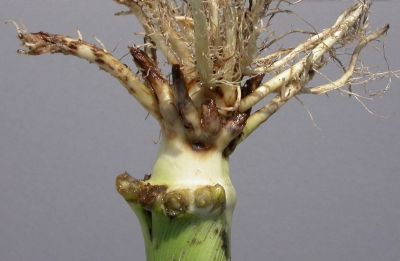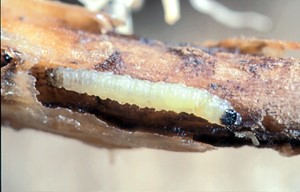 Image 1. Corn rootworm injury on corn roots. (Source: GROWMARK, Inc.)
Image 1. Corn rootworm injury on corn roots. (Source: GROWMARK, Inc.)
- Corn rootworms (CRW) are one of the most important insect pests of corn in the Midwest with the potential to cause significant yield losses and increase lodging.
- Corn rootworm egg hatching has started and larval feeding is underway in many parts of the Midwest.
- Monitoring feeding injury can help determine the effectiveness of a hybrid or insecticide treatment, whereas monitoring adults may help with management decisions the next season
Corn rootworms (CRW) are one of the most important insect pests of corn in the Midwest. Root feeding by the larvae can cause significant yield losses and increase lodging. A compilation of field research trials suggests that around 15% yield reduction can occur for each nodal root consumed by CRW larvae (Tinsley et al. 2013).
Biology
Female CRW beetles lay eggs in the soil in late summer, generally between August and early September. Eggs overwinter and resume development the following spring when soil temperatures increase. Peak CRW egg hatch occurs between 684 and 767 accumulated degree days (52°F base soil temperature). Once CRW eggs hatch, larvae need to find corn roots within a few hours, or they will die. As a general rule of thumb, the start of lightning bug activity or cottonwood seed dispersal typically coincides with CRW egg hatch.
As the larvae mature, they preferably feed and on nodal roots. This activity not only reduces the ability of the plant to acquire water and nutrients, but also depletes standability, increasing the likelihood for lodging at the base of the plant. Adults emerge, mate, and females lay eggs, typically where mating occurred. There are some populations of CRW that have a behavioral adaptation where they may lay eggs in non-hosts such as soybeans. Still others have an adaptation where some eggs will remain dormant for more than one year and hatch the following season. What does this mean? It means that rotation to a crop other than corn for one season, which will starve and kill hatching CRW larvae, may not be as effective in situations where the local population is comprised of a large number of these adapted individuals. However, in most situations adults mate and lay eggs in the same corn field where they mated. Therefore monitoring adult populations during the growing season can help determine where CRW populations may be elevated the following season.
Symptoms of CRW Damage
Damage of CRW is evident as pruned nodal roots and “goosenecking” of corn at the base. Goosenecking is more likely to follow severe wind events, followed by a recovery period. In some instances, root regrowth may be observed near pruned nodal roots.
How can we evaluate CRW damage?
Sometimes we want to know if a hybrid or insecticide worked well, particularly if it is the first time we have used it. In these cases, assessing the larvae or the damage they cause may be a benefit.
a. Assessing the impacts of CRW larvae
Scouting should start about two weeks after peak hatch but can also be done later in the season to evaluate the extent of root damage. To evaluate the number of larvae present, carefully dig and remove a 7” x 7” cube of soil around the base of one plant in at least ten locations of the field. Sample from across the field, starting at least 50’ from field edges. Place and crumble the soil over a dark background such as a black trash bag or tarp and examine for CRW larvae. Alternatively, you can immerse the sample in a bucket of water and if CRW larvae are present, they will float to the surface. Finding an average of two or more larvae per plant using the soil crumbling method or eight or more using the float method may indicate the potential for economic damage and elevated lodging potential. Larvae are white and thin, approximately 0.5 inches long, with dark heads and black plates at their tail end.

Corn rootworm larvae. (Image J. Obermeyer Purdue)
b. Assessing activity of larvae on root system
To determine the severity of root damage, evaluate root injury around mid-late July. Dig one plant in each of ten randomly selected areas and wash the roots to remove the soil. Using the Iowa State node injury scale (https://www.ent.iastate.edu/pest/rootworm/nodeinjury/nodeinjury.html) , rate the roots from 0-3 where 0 = no damage and 3 = three or more nodes have been eaten. Partial scores can be given (for example a 1.5 would indicate one and a half nodes, 1.75 would equal 1 and ¾ nodes); however, this level of detail is typically only needed for trait evaluation and research purposes. Root tips will appear brown to black and pruned to the plant base. Larvae may also be found tunneling into roots and crowns.
Where to sample first for larvae and damage? High risk fields should be sampled first. These include:
- Fields planted with hybrids without CRW Bt traits
- Fields with a history of CRW Bt trait failures
- Fields on continuous corn
- Fields with high CRW beetle counts the previous year
c. Scouting for adults:
Western and Northern CRW are the two species of interest in the Midwest. Western CRW are roughly 5/16” long, yellow to green in color, and contain black stripes or covers on the forewings (elytra). Conversely, Northern CRW are slightly smaller, about 1/4'”long, with a creamy tan to green color.
To scout a field, start at least 50’ from field edges and scout 10 areas across the field in a “W” pattern. At each site assess five non-consecutive plants for CRW adults. To count adults, reach out and cover the silks in your hand to trap beetles feeding in silks and prevent them from moving to other parts of the plant and/or escaping. While holding the silks, assess the leaves and ear axels for adults. Finally, remove your hand from the silk and count the number of adults in and exiting the silks. If adult beetle counts average more than 0.75 beetles per plant across the field, that field would be at elevated risk for CRW larvae the following season.
Other methods to monitor adults include the use of sticky traps and CRW monitoring networks. This year FS crop specialists across the United States and Canada are participating in monitoring efforts for this pest to ensure that their growers are informed as to the best management strategies for CRW on their farms. Contact your crop specialist for further information on participating in these networks.
Summary
Corn rootworm resistance to Bt traits was first documented in 2009 and cross-resistance was confirmed soon thereafter. Scouting provides information about the performance of CRW Bt traits and can help diagnose resistance development in a field. Regarding CRW adult counts, they can help predict the potential for CRW larval damage in specific areas in the following season. Even though low CRW populations have been observed in recent years, a few hot spots have been consistently identified across surveyed areas. Scouting is key to predict the potential for CRW damage and adjust our future management practices accordingly.
References and Resources:
Tinsley, N.A., R.E. Estes, M.E. Gray. 2013. Validation of a nested error component model to estimate damage caused by corn rootworm larvae. Journal of Applied Entomology. 137(3):161-169
Illinois insect degree day calculator: https://data.prairie.illinois.edu/